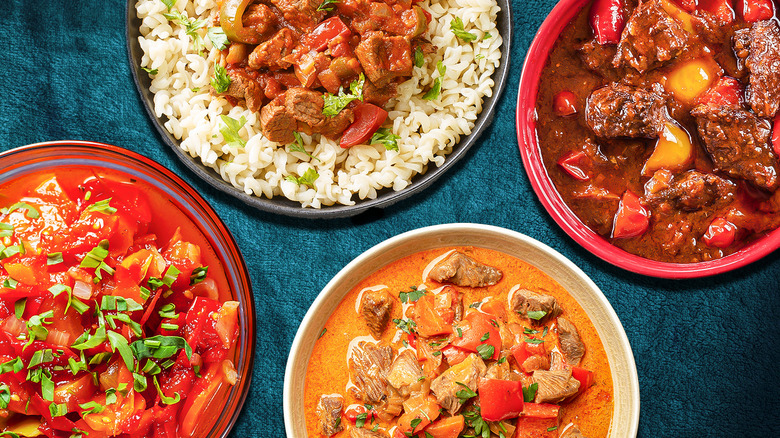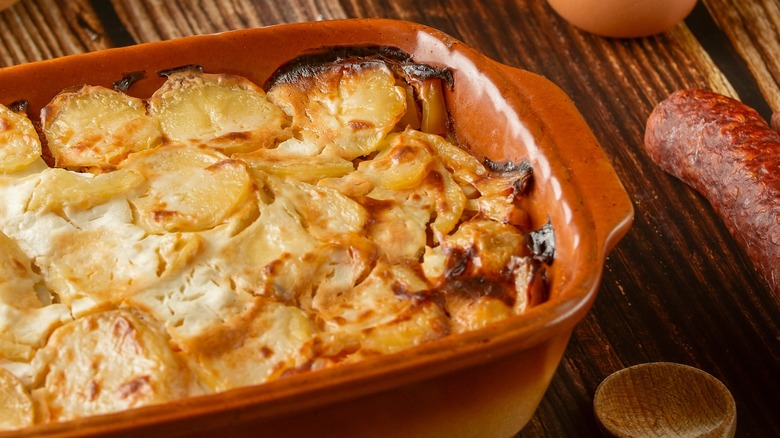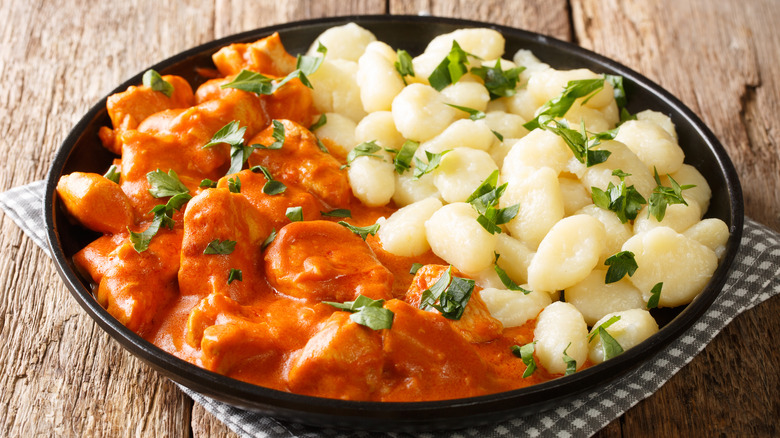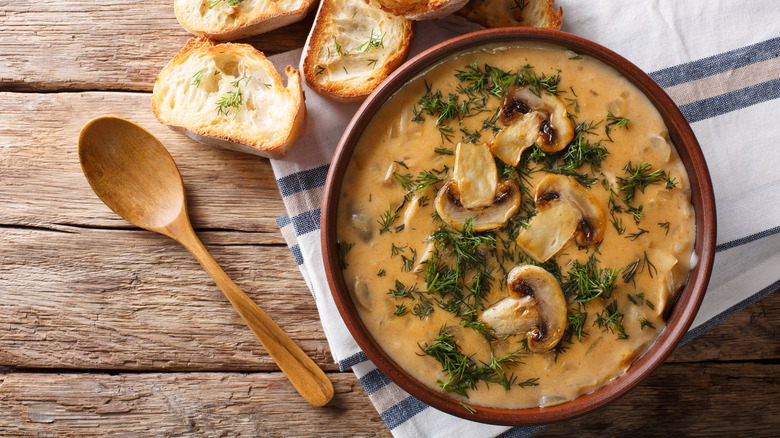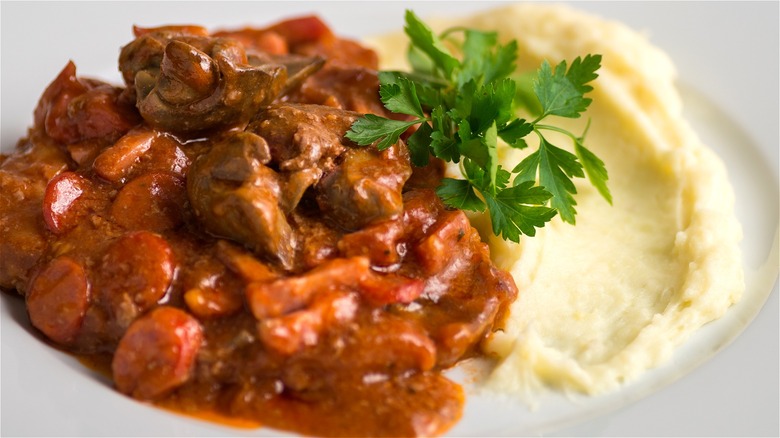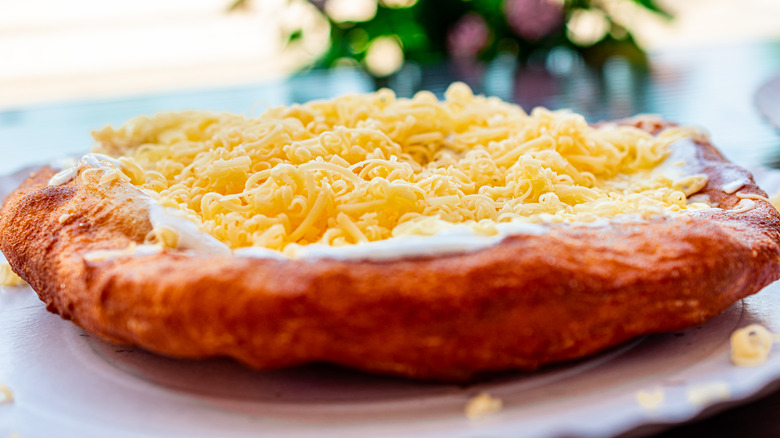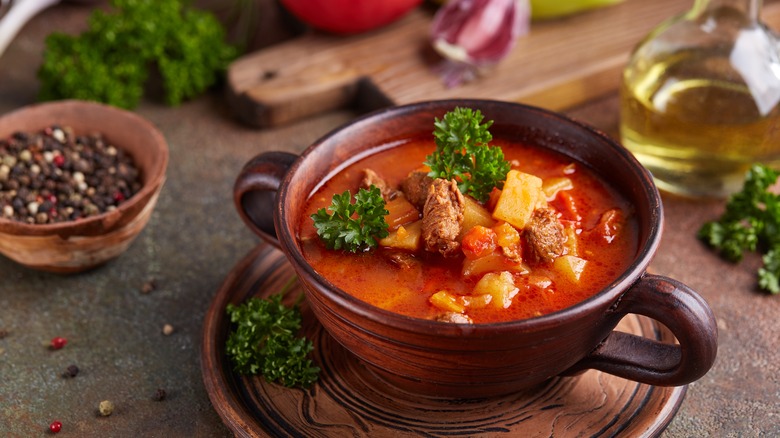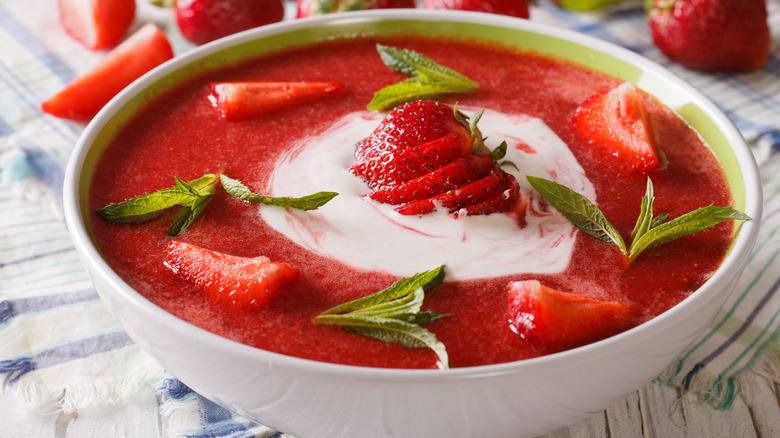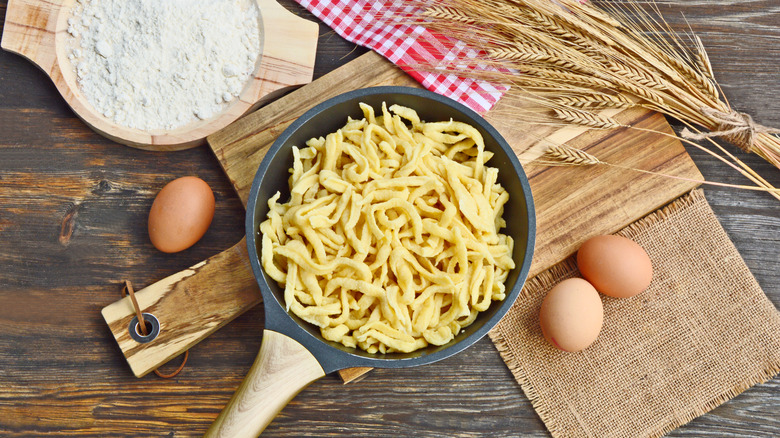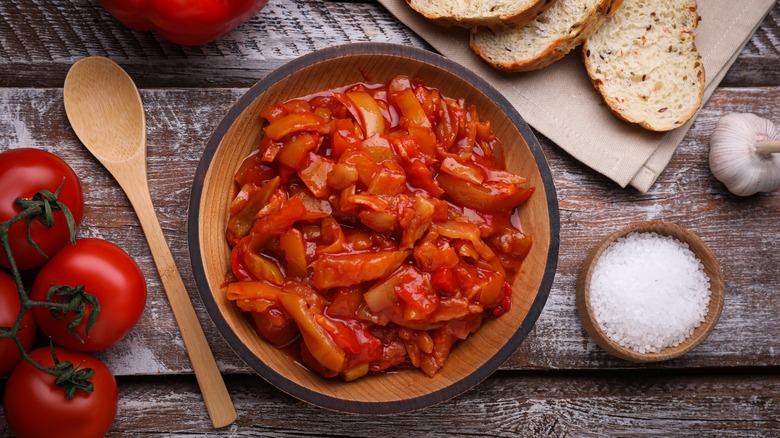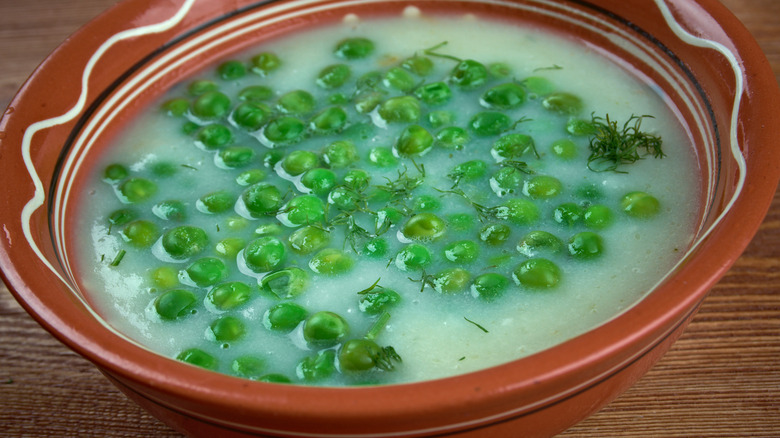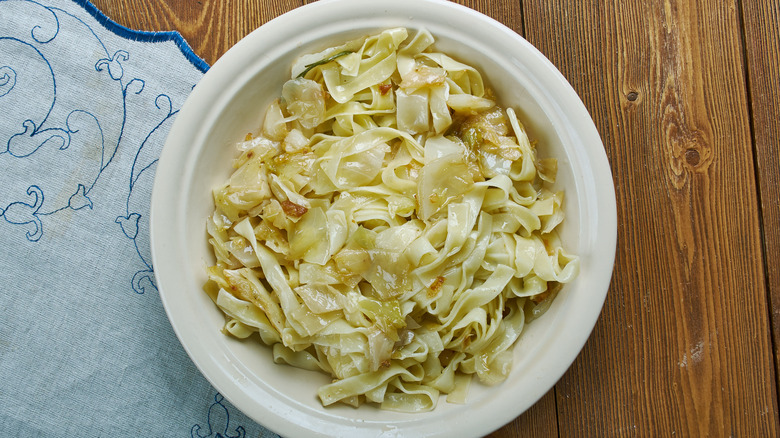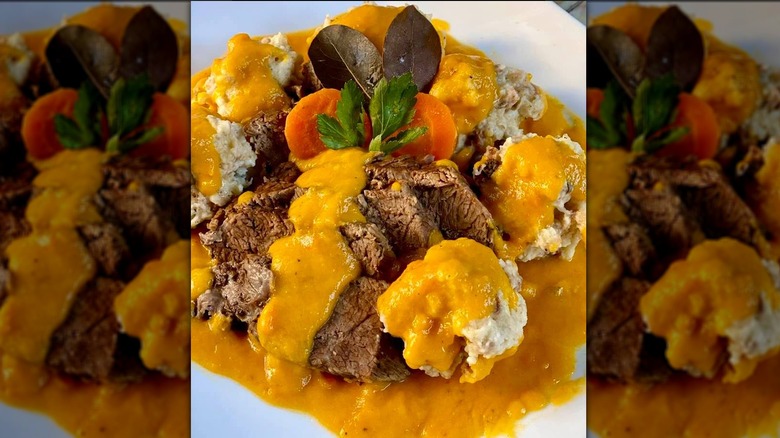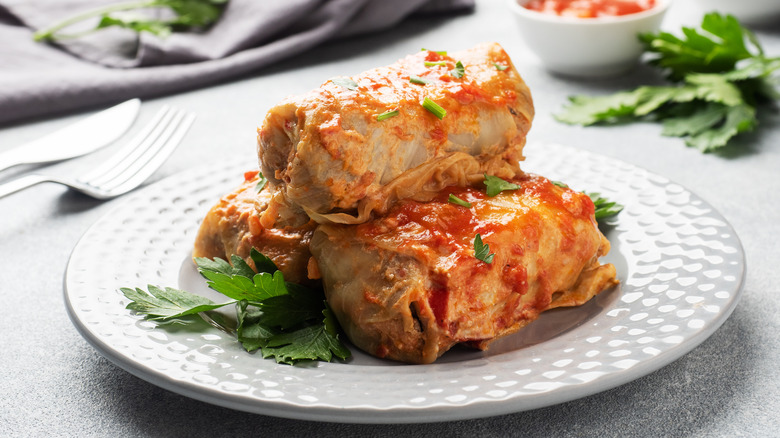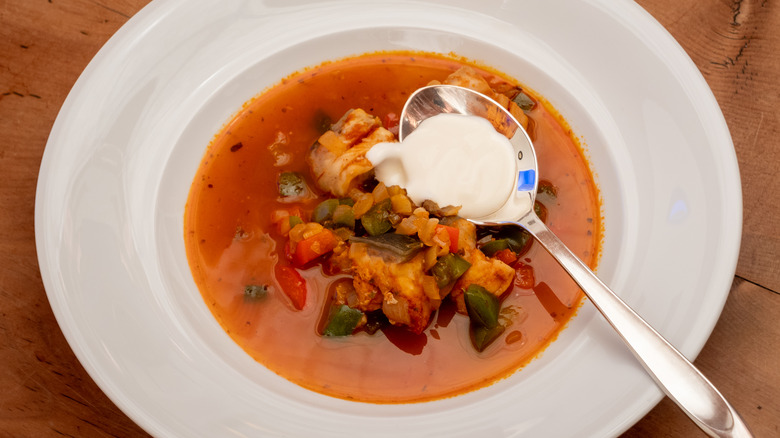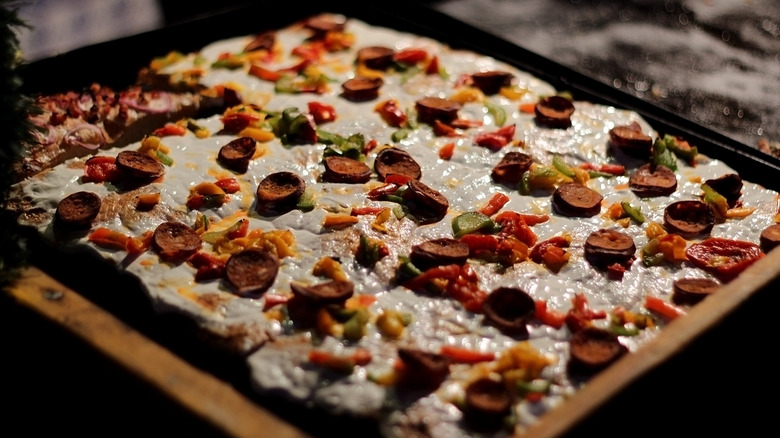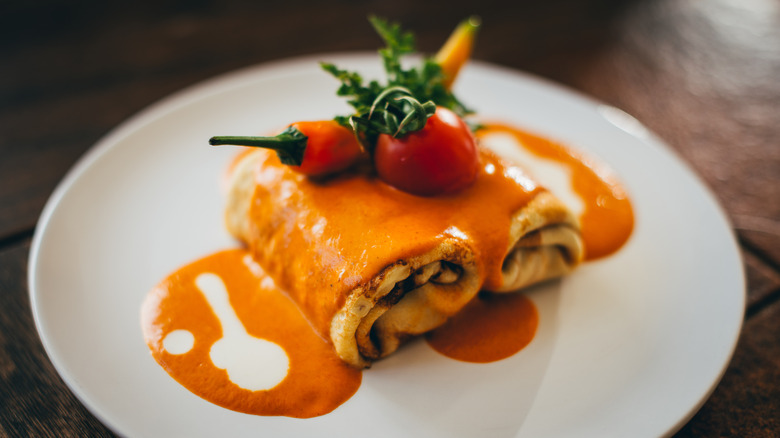16 Hungarian Dishes You Need To Try At Least Once
With a landscape that stretches from the northeastern Bükk peaks to the coast of Central Europe's largest freshwater lake and on to the Carpathian Basin's flat grassy stretches, Hungary's culinary identity thrives on its rich agricultural history. Most of its dishes have humble backgrounds — invented by herders or fisherfolk — and there's something particularly charming, homey, and surprisingly scrumptious about that. Equally though, the country has produced countless delights once relished by the nobility, and while Hungary's dishes may carry the weight of history and tradition, they also challenge stereotypes. Beyond the goulash we all know and love, there's so much to discover: diverse flavors, vibrant colors, and fascinating stories.
Let's take a virtual journey across the country to uncover Hungary's most unforgettable plates, including a dish that might be as addictive as pizza, an intriguing take on mushroom soup, and other authentic Magyar recipes that will make the most of that paprika that's been sitting in your cupboard.
Layered potatoes (rakott krumpli)
Rakott krumpli is a hearty and robust dish, often served as a main course rather than a side, and it's beloved as comfort food for millions of Hungarians. This casserole-like dish showcases layers of potatoes atop slices of hard-boiled eggs and distinctively flavored Hungarian smoked sausage, called kolbász. The meaty, smoky, and paprika-infused flavor of the kolbász plays a crucial role in the overall dish, so many opt for thick Gyulai kolbász, while some prefer spicier varieties from the southeast of Hungary. If you can't find traditional Hungarian sausage, choose a smoked pork sausage with a deep flavor.
The sauce ties this dish together: a rich and subtly acidic sour cream (sometimes diluted slightly with milk) spread over the layers of potatoes, eggs, and sausages. To finish, we sprinkle paprika before baking it in the oven until the top layer of potatoes turns irresistibly crispy.
Chicken paprikash (paprikás csirke)
Paprika, a seasoning ground from chili peppers, is widely considered the national spice of Hungary. Its mildly smoky flavor and more balanced, rich depth of flavor lends its name to one of Hungary's most eminent dishes, traditional chicken paprikash — or, as it's called in Hungarian, paprikás csirke.
In Hungary, paprikash dishes aren't limited to chicken; firm catfish is another popular choice, although less prevalent. The short ingredient list highlights the simple yet effective deliciousness of seared bone-in chicken pieces fried in lard for added flavor (though vegetable oil also works), alongside caramelized onions and the classic sweet paprika.
Chicken paprikash bears a striking resemblance to another Hungarian must-try, pörkölt (meat stew). The final touch of sour cream, stirred through at the end of cooking, infuses the dish with a creamy richness and hint of tanginess, elevating it to the next level. Serve your vibrant paprikash with homemade späetzle-like dumplings called nokedli, or with simple boiled potatoes.
Mushroom soup (gombaleves)
Gombaleves, a warming Hungarian mushroom soup with an earthy, umami-rich flavor of mushrooms, offers a rare vegetarian-friendly meal in the meat- and fish-dominated landscape of Hungarian cuisine — and in this case, you won't miss the meat. If you can find forest mushrooms seasonally in grocery stores, that is ideal, but otherwise, opt for cremini or white mushrooms. Hungarian mushroom soup is a comfort food full of traditional flavors — starting with a classic soup base of onions and sliced mushrooms. Next, broth and paprika are added to the pot before a mixture of flour and milk, along with sour cream, lemon juice, parsley, and dill. The whole dish is left to cook with until soft and aromatic.
Gombaleves achieves its creaminess through its sour cream rather than being pureed like a typical cream of mushroom soup. To finish, garnish the soup with more dill, and for a heartier meal, consider adding csipetke (pinched noodles).
Meat stew (pörkölt)
Bursting with flavor and using just a few ingredients, pörkölt is everything to love about Hungarian cuisine: stewed meat typically flavored with onion, garlic, paprika, tomato, and green peppers. The thick, meaty dish widely called goulash in the U.S. is actually considered as a pörkölt within Hungary. Traditionally, beef, chicken, or pork is the star of this stew, though the adventurous might explore other meats like beef tripe, and pescatarians can enjoy catfish-based pörkölt.
Each household's recipe boasts its unique twist: some emphasize the robustness of caraway seeds, while others elevate it with a touch of tarragon or marjoram. The key is the slow simmering, coaxing out the rich essence of paprika and infusing the meat with its distinct piquancy. The sauce is thick and glossy — just enough to coat the meat and flavor its side dishes, which can be nokedli, potatoes, or rice. Unlike chicken paprikash, pörkölt isn't finished with sour cream, resulting in more opportunities to savor the paprika, sweetened onions, and succulent meats.
Deep-fried flatbread (lángos)
Sometimes, the best way to experience a country's cuisine isn't through fancy restaurants, but street food. Lángos, a Hungarian fried-dough specialty, is one of Hungary's best examples of this wisdom. This heavy snack started as a clever way to use leftover bread dough scraps, made by cooking the small pieces while the bigger loaves baked in the oven. By the 1950s, it evolved into the deep-fried treat known today, and further surged in popularity during the '70s, with chefs adding various toppings.
Despite its irresistible taste, lángos is a straightforward yeast dough made solely from flour, salt, oil, sugar, and water. Plus, this dough doesn't require resting before frying, so it's speedy to make at home. Some people rub the freshly fried golden-brown bread with garlic sauce, while others top it with a slathering of sour cream and grated cheese — but your imagination is the limit.
Goulash soup (gulyás)
One of Hungary's most famous dishes, known globally as goulash and referred to locally as gulyás, is a testament to the worldwide success of Hungarian cuisine. Across the U.S., Hungarian immigrants popularized this flavorful dish as it evolved over generations into a new specialty. But what's the difference between Hungarian and American goulash?
Hungarian gulyás varies regionally, but it is a thick soup ordinarily including meat (often beef, though pork or lamb are alternatives), root vegetables, and peppers. Originating from shepherds on the Great Hungarian Plain, today it usually contains a few unique ingredients: parsley root, sharp and nutty caraway seeds, and the ingredient Hungarian goulash always uses — paprika. Start by sauteeing onions, garlic, and the meat, followed by aromatics and paprika. Include peppers, tomatoes, and water, then simmer. Later, add the root veggies.
Conversely, American goulash is a stew often involving large pasta, ground meat, and a thicker sauce (unlike the thinner Hungarian gulyás). If you have the opportunity, taste the authentic version and compare.
Cold fruit soup (gyümölcsleves)
Hungarian gyümölcsleves, a chilled fruit soup, may appear odd to the uninitiated, but it's a coveted summer treat across Central and Eastern Europe. Its tart yet subtly sweet taste, often laced with aromatic spices, serves as a refreshing starter amidst the region's hearty cuisine, and can even be enjoyed as a dessert. In Hungary, the most prevalent variety of cold fruit soup is sour cherry, although the dish can be adapted to include any in-season fruits, including but not limited to strawberries, blackberries, and plums — or an assortment of different fruits mixed together.
Here's a straightforward method for this delightful soup: mix your favorite fruits with water, a pinch of salt, sugar, lemon juice, citrus zest, and cinnamon sticks. Let the mixture simmer until the fruits soften and the aroma of spices fills the kitchen. Afterward, remove the spices and chill your gyümölcsleves before serving.
Fresh pasta dumplings (nokedli)
While you may associate fresh pasta with Italy, many Central and Eastern European countries, including Hungary, have rich cultural traditions involving handmade versions of this staple. For example, csipetke, or "pinched pasta," is a mainstay of Hungarian soups and stews, such as goulash and Jókai bableves (a type of bean soup). However, while the csipetke dough is stiff, nokedli — known in Germany and Austria as spätzle — uses egg, flour, salt, and water, resulting in a soft and sticky dough. The unique preparation stems from the dough's stickiness: it's pushed through holes in a colander-like contraption that sits over the pot, so the pasta dumplings fall straight into boiling water. The pasta is ready when it floats, which usually takes just a few minutes.
Nokedli is adored as a beloved side dish for its economic value and easy cooking — the process takes less than 30 minutes from beginning to end. Cooks often toss the soft pasta in melted butter and fresh parsley, then serve it with pörkölt (meat stew) or chicken paprikash. However, there's no reason to limit yourself to Hungarian dishes, since the pasta complements other European foods equally well.
Pepper stew (lecsó)
Smoky, mildly spicy, and heaping with full-bodied flavor, pepper stew — or lecsó — is an indispensable part of Hungarian cuisine, especially in late summer. The dish starts with rendering the fat from bacon, then adding special Hungarian smoked kolbász sausages, onions, juicy tomatoes, and peppers. These aren't just any old peppers, though. Hungarian wax peppers (TV paprika) have a slight tang and heat similar to a jalapeño. We can't forget the seasoning — sweet paprika, an ever-important part of Hungarian cuisine that lends a fruity, tart sweetness to the plate.
The thick, vitamin-rich sauce of lecsó is perfectly enjoyable mopped up with a chunk of crusty white bread. And, of course, we can't forget pickled vegetables — an essential component of any Hungarian meal. It may not be strictly conventional (shh), but this pepper stew also makes for a particularly filling breakfast, especially with a fried egg; it becomes almost reminiscent of shakshuka. The dish is also easily adaptable and can be made vegetarian or vegan fairly effortlessly by replacing lard with oil and substituting sausage with a plant-based alternative.
Pottage (főzelék)
Chances are you haven't heard of pottage, but it was a go-to staple in Northern Europe a few centuries back. In the modern age, most Europeans consign this mysterious meal — a culinary blend between a hearty stew and comforting soup — to old cookbooks, but in Hungary, pottage has endured through time as főzelék. Somewhat of a culinary hidden gem, főzelék is a favorite homemade lunch, offering respite from heavier traditional plates.
Főzelék embodies a category of food rather than a single, specific dish. Like most traditional Hungarian foods, it's cooked in lard, so pottage isn't automatically vegetarian (although if you make it at home, you can substitute lard with oil or butter). However, the base of the dish can be as far ranging as potato, sorrel, lentils, green peas, spinach, carrot, pumpkin, or a combination of these and much more, depending on the season.
The dish is simple: gently heat your chosen vegetable(s) in oil or butter, optionally with garlic and onion, then add water or milk and simmer until soft. The pottage is thickened with a roux or sour cream, can include aromatics like bay leaves or other herbs, and nearly always has a pinch of sugar for a hint of sweetness. Some Hungarians prefer to add a topping of bacon, meatballs, or spicy stewed meats.
Fried cabbage and noodles (káposztás tészta)
Two simple ingredients, cabbage and noodles, form the basis of this versatile dish, known in Hungarian as káposztás tészta. It's likely the most simple of all iconic Hungarian plates and one of the most adaptable, too. This basic dish involves frying grated cabbage in plenty of butter until it's beautifully caramelized and evenly golden. The idea is to bring depth of flavor to the dish, extracting all the sweetness from the simple vegetable. Next, boil your pasta (traditionally, káposztás tészta uses small, square-shaped, flat egg noodles) until al dente, then add it to the pan along with the cabbage and season with salt.
Undeniably simple, yes. But also surprisingly tasty, with natural sweetness and a slight chewiness from the pasta — the perfect foundation to add more personal touches. Some cooks enhance the caramelized flavors by incorporating sugar into the pan. Others introduce umami by tossing in crumbled bacon or chopped ham, opt for a hint of spice using black pepper, or aim for character by adding paprika from the city of Szeged.
Hunters' stew (vadas)
Of all Hungarian meat dishes, vadas — typically called hunter's stew, but served more like a saucy coating — is one of the most intensive to prepare, often requiring an entire afternoon to fully draw all the flavors from the meat (typically beef). Most cooks slowly simmer the meat until it reaches juicy tenderness, taking up to three hours. Our attention then turns to the sauce, which is crucial to the dish and delightfully zesty. We achieve its flavor by slow-cooking the seared meat with root vegetables, water, bay leaves, sugar, carrots, lemon, and mustard — a lending a gorgeous citrusy, aromatic, and subtly earthy seasoning.
Once the meat is mouthwateringly juicy and tender, take everything out of the pan and blend the vegetables into a smooth puree, thickening it with some flour. The result should be a heavy, perfectly balanced, lip-smackingly tangy and sweet sauce perfect to pour over the succulent beef or game meat — which itself has rich notes of earthy and grassy flavor. Traditionally, home cooks serve vadas alongside homemade bread roll dumplings, but it can also be complemented with potato dumplings, boiled potatoes, rice, or nokedli.
Pork-stuffed cabbage rolls (töltött káposzta)
The cold, harsh winters of Hungary call for comforting, nourishing meals. Widely beloved are cabbage rolls, or töltött káposzta — an Eastern European classic that finds a place of honor on Hungarian dinner tables during Christmas festivities, especially Boxing Day.
Cabbage rolls are incredibly versatile, and recipes vary between families, with the stuffing usually made from ground pork, onions, eggs, and garlic, then seasoned with black pepper, sweet smoked paprika, caraway seeds, bay leaves, and piney dried marjoram. Once you've filled the cabbage leaves, Hungarian recipes agree you should layer the bottom of your pot with a mixture of paprika-seasoned sauerkraut and onions. The sauce, however, is a point of contention; some cooks cover the rolls with a rich tomato sauce, while others opt for stock or a meaty brown gravy. Serving everyone from the large pot is a great experience — just be sure to top the tender, juicy, and bursting-with-flavor rolls with sour cream.
Spicy fish soup (halászlé)
You may not associate Hungary, a landlocked country, with seafood — but in regions next to large lakes or rivers, the culinary tradition of fish-based meals thrives. Fishermen along the Danube and Tisza rivers catch wild freshwater fish (typically carp, catfish, or perch) and set up a small fire next to the riverbank, slow-cooking pots of rich fish soup called halászlé that they'd soak up with soft white bread.
Halászlé is made differently depending on the region. On the far southern border of Hungary, the soup is made with a medley of fresh fish, while in the city of Baja a little further north, you might find egg noodles in the soup. Nonetheless, it typically features a spicy and rich broth with combinations of paprika, lending the soup its characteristic fiery hue and a simultaneously hot and sweet profile. Simmer this mixture with some onions, umami-heavy tomato paste, and a splash of white wine, and you have soup worthy of a Hungarian fisherman.
White pizza (kenyérlángos)
One bite of kenyérlángos, and you'll be in heaven. This topped flatbread is not unlike Italian pizza, although it's typically softer and thicker, doesn't have a distinctive crust, and forgoes the rich tomato sauce. Although kenyérlángos is a year-round pleasure, it's especially popular during the Christmas holidays, when markets serve up slices alongside mulled wine.
Kenyérlángos came about in much the same way as lángos, but although the latter evolved into a deep-fried treat, this Hungarian pizza remained true to its roots by staying oven-baked. This difference changes the texture substantially; kenyérlángos has a crisp bottom but almost focaccia-like light, rich, and chewy center. The top remains soft, thanks to a classic blend of sour cream, garlic, smoked bacon, and red onions slathered on top prior to baking. Chopped peppers and smoked sausages are another prevalent addition, adding a depth of smoky sweetness to the bread. Toppings vary; in northern regions, the kenyérlángos is completed with a cottage cheese and dill mixture.
Savory meat stuffed crepes (Hortobágyi palacsinta)
Did you know that crepe dishes can be savory, too? In Hungary, there are two types of crepe: palacsinta, a (usually) sweet filled thin pancake not dissimilar to the Jewish blintz, and Hortobágyi palacsinta, a crepe filled with an intensely savory, rich, meaty stuffing. It's a unique recipe we highly recommend if you visit this beautiful country — although you can just as easily skip the flight and whip up some Hortobágyi palacsinta at home.
The stuffing usually starts with ground meat (often chicken), onions, paprika, fresh herbs, and occasionally tomatoes, cooked down until it's tender and aromatic. The ground meat is drained from the sauce, since we don't want the crepes to become soggy — but save those rich cooking juices. Whisked together with plenty of sour cream and flour, this becomes an irresistibly creamy sauce excellently suited for drenching the delicate crepe rolls.
